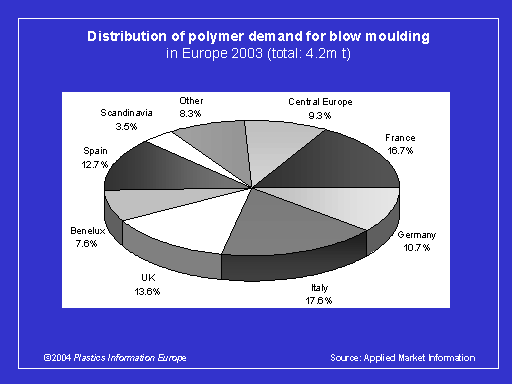BLOW MOULDING INDUSTRY
Consistent growth in European polymer demand / PET and HDPE lead / AMI study
The blow moulding sector, with currently over 1,300 companies in Europe, has been one of the more consistently performing areas in the plastics industry in recent years, says a recently published report by Applied Market Information (AMI, GB-Bristol BS1 3QP; www.amiplastics.com). The report, “AMI´s guide to the blow moulding industry in Europe”, says demand for blow moulded containers has consistently grown over an increasing range of applications. In terms of polymer usage, the sector has advanced by 4.5% per year since 2000, thanks in part to developments such as PET bottles, the use of plastic fuel tanks and the emergence of HDPE containers to replace glass and cartons for juice and milk packaging.
According to AMI, the European blow moulding industry used nearly 4.2m t of polymer in 2003, of which over 90% was HDPE and PET. The latter has become the fastest growing polymer for blow moulding due to its penetration in the soft drinks market replacing glass, polyvinyl chloride (PVC) and tinplate. The emergence of PET has led to a rapid decline in the use of PVC bottles.
The consultants point to a shift in the distribution of overall polymer demand for blow moulding among European countries. Traditionally, France was the largest market, due largely to its use of PVC bottles for mineral water. However, the rapid growth of PET in Italy in recent years has seen this regional market emerge as the largest. In 2003 it accounted for 17.6% of polymer used in blow moulding in Europe, compared with 16.7% for France. Germany ranks fourth behind the UK.
Book Service: “AMI´s guide to the blow moulding industry in Europe”, 6th edition 2004, 318 pages, A4, soft cover, EUR 285.00 + VAT: PIE-No. B 46430.
According to AMI, the European blow moulding industry used nearly 4.2m t of polymer in 2003, of which over 90% was HDPE and PET. The latter has become the fastest growing polymer for blow moulding due to its penetration in the soft drinks market replacing glass, polyvinyl chloride (PVC) and tinplate. The emergence of PET has led to a rapid decline in the use of PVC bottles.
The consultants point to a shift in the distribution of overall polymer demand for blow moulding among European countries. Traditionally, France was the largest market, due largely to its use of PVC bottles for mineral water. However, the rapid growth of PET in Italy in recent years has seen this regional market emerge as the largest. In 2003 it accounted for 17.6% of polymer used in blow moulding in Europe, compared with 16.7% for France. Germany ranks fourth behind the UK.
Book Service: “AMI´s guide to the blow moulding industry in Europe”, 6th edition 2004, 318 pages, A4, soft cover, EUR 285.00 + VAT: PIE-No. B 46430.
 | |
02.09.2004 Plasteurope.com [200650]
Published on 02.09.2004

 German version of this article...
German version of this article...